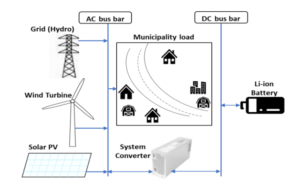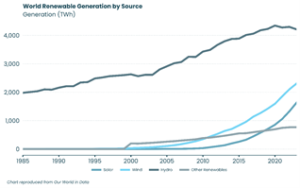It isn’t recognized generally yet, but the combination of solar, wind and batteries can supply the whole world with electricity. Writes RethinkX in its latest newsletter. This is happening already in many parts of the world, part of the year. ‘In spite of scepsis by mainstream analysts and incumbent interests.’

Very fast growth
In the American state of California, this year solar projects totalled a new high of 17,170 MW, a thousand MW more than last year’s peak and sufficient to power millions of households. The proportion of solar power in the peak was spectacularly high, 86.4% of electricity demand. Moreover, battery storage reached an all-time high. California constructed 6,600 MW of battery storage, an increase by 1020% since 2020.
On the other end of the world, the Indian megacity of Mumbai was powered by sustainable electricity (solar, wind and batteries) for four hours on November 12, from 10 to 14 o’clock. According to the electricity company, it powered 38% of customer demand by sustainable electricity.
Australia: exceptional results
On a much smaller scale, in the Aboriginal community of Titjikala in Australia’s Northern Territory, a micro network of solar cells and batteries was successful. In September, this supplied an average of 83% of sustainable energy, often even 100%. The regional Labor government wants this system to be generally applied, creating green jobs and reducing emissions.
Even more stunning, the South Australian Company Electranet expects to reach ‘net’ 100% renewables within four years. Already, South Australia is world-leading in solar, wind and batteries, with a share of more than 71.5% in its grid. This is all the more remarkable as South Australia only has solar and wind energy – virtually no hydro, geothermal or biomass. South Australia would be the first grid of its size to reach the milestone of 100% renewables.
A recent analysis by Argonne and NREL has shown that it is even possible to host 100% solar, wind and batteries storage in the South Pole. Solar and wind power can cut diesel usage by 95%. With addition of lithium-ion batteries, this percentage cold rise to 100%.

New records
But then, RethinkX writes, this is just the beginning. Developers and power plant owners in the US plan to add a record amount of 62.8 gigawatts (GW) of new utility-scale electric-generating capacity in 2024; according to the US Energy Information Administration. This is 55% above the 40.4 GW added in 2023, already a record high. Solar would account for 58% of the new capacity, followed by battery storage at 23%.
In 2022, wind and solar accounted for 14% of U.S. electricity generation. This percentage is rising, to 16% of total generation in 2023 and 18% in 2024. RethinkX comments that this seemed almost impossible just a decade ago. Battery capacity even rises more quickly, additions in 2024 are expected to be double those of 2023. Batteries form an essential link in this system.
And then, we didn’t even consider China. There, progress is even more spectacular. Solar, wind and batteries are expected to comprise 40% of total power generation capacity by the end of 2024.
Solar, wind and batteries growing fast
So all in all, RethinkX writes, solar, wind and batteries (SWB) are still growing exponentially worldwide. They show no signs of slowing down. This puts leading regions on track to 100% SWB by 2030. In the world’s most populated regions, this milestone will be reached later – but still, they are now expected to reach zero carbon electricity before 2040. Thanks to SWB, clean energy superabundance is finally within humanity’s reach, RethinkX concludes.
Interesting? Then also read:
Solar and wind energy revisited
Ten times as much solar energy
Sustainable energy: keeping the score. Part 2: The role of sun and wind
